DeWalt DCL061 Handleiding
DeWalt
Boormachine
DCL061
Bekijk gratis de handleiding van DeWalt DCL061 (7 pagina’s), behorend tot de categorie Boormachine. Deze gids werd als nuttig beoordeeld door 90 mensen en kreeg gemiddeld 4.6 sterren uit 45.5 reviews. Heb je een vraag over DeWalt DCL061 of wil je andere gebruikers van dit product iets vragen? Stel een vraag
Pagina 1/7

Defi nitions: Safety Guidelines
The definitions below describe the level of severity for each signal word. Please read the
manual and pay attention to these symbols.
DANGER: Indicates an imminently hazardous situation which, if not avoided, will
result in death or serious injury.
WARNING: Indicates a potentially hazardous situation which, if not avoided, could
result in death or serious injury.
CAUTION: Indicates a potentially hazardous situation which, if not avoided, may result
in minor or moderate injury.
NOTICE: may Indicates a practice not related to personal injury which, if not avoided,
result in property damage.
IF YOU HAVE ANY QUESTIONS OR COMMENTS ABOUT THIS OR ANY D WALT TOOL, CALL E
US TOLL FREE AT: 1-800-4-DEWALT (1-800-433-9258).
Important Safety Instructions
WARNING! When using the worklight, basic precautions should always be
followed, including the following:
a. Read all the instructions before using the worklight.
b. To reduce the risk of injury, close supervision is necessary when a worklight is used near
children.
c. Do not use outdoors.
d. To disconnect, turn all controls to the OFF position, then remove plug from outlet.
e. Do not unplug by pulling on cord. To unplug, grasp the plug, not the cord.
f. Unplug from outlet when not in use and before servicing or cleaning.
g. Do not operate any worklight with a damaged cord or plug, or after the worklight has received
a sharp blow, malfunctions or is dropped or damaged in any manner. Return worklight to
the nearest authorized service facility for examination, repair, or electrical or mechanical
adjustment.
h. To reduce the risk of electrical shock, do not put worklight in water or other liquid. Do not
place or store worklight where it can fall or be pulled into a tub or sink.
i. Connect to a properly grounded outlet. Refer to Grounding Instructions.
SAVE THESE INSTRUCTIONS
Specifi c Safety Rules for Worklights
WARNING: Fire hazard. Do not operate worklight or charger near flammable liquids or in
gaseous or explosive atmospheres. Internal sparks may ignite fumes causing personal injury.
• Do not expose worklight to wet or damp areas. Use only indoors in a dry location. Do
not allow any liquid to get inside worklight. Do not submerge worklight in any liquid.
• The worklight is intended for household and commercial use.
• Before using battery and charger, read all instructions and cautionary markings on charger,
battery pack, and product using battery pack.
• DO NOT attempt to charge the battery pack with any chargers other than the ones in
this manual. The worklight and battery pack are specifically designed to work together.
• Pull by plug rather than cord when disconnecting worklight. This will reduce risk of
damage to electric plug and cord.
• Make sure cord is located so that it will not be stepped on, tripped over, or otherwise
subjected to damage or stress.
• Use only a proper extension cord that is necessary to operate the DCL061 worklight on
AC power (refer to Use of Extension Cords with Worklight). Use of an improper extension
cord could result in risk of fire, electric shock, or electrocution.
• Place the worklight in a position away from any heat source.
• Do not disassemble worklight. Take it to an authorized service center when service or
repair is required. Incorrect reassembly may result in a risk of electric shock, electrocution or
fire.
• Disconnect the worklight from the outlet before attempting any cleaning. This will
reduce the risk of electric shock. Removing the battery pack will not reduce this risk.
• The DCL061 worklight is designed to operate on 120 Volts, 60 Hz AC. Both the DCL060
and DCL061 operate on direct current (DC) through fully charged DEWALT 18V nickel cadmium,
nickel metal hydride, lithium-ion battery packs and DEWALT 20V Max* lithium-ion battery packs.
Do not use any other voltage.
• Use type SJ, SJE, SJO, SJOO, SJT, SJTO, or SJTOO cord when operating the worklight
on AC power.
WARNING: Do not place the worklight in a position which may cause anyone to
intentionally or unintentionally stare into the light. Serious eye injury could result.
CAUTION: When not in use, place worklight on a stable surface where it will not cause
a tripping or falling hazard. Some products with large battery packs will stand upright on the
battery pack but may be easily knocked over.
This Class B digital apparatus complies with Canadian ICES-003.
NOTE: This equipment has been tested and found to comply with the limits for a Class B digital
device, pursuant to Part 15 of the FCC Rules. These limits are designed to provide reasonable
protection against harmful interference in a residential installation. This equipment generates,
uses and can radiate radio frequency energy and, if not installed and used in accordance with
the instructions, may cause harmful interference to ratio communications. However, there is no
guarantee that interference will not occur in a particular installation. If this equipment does cause
harmful interference to radio or television reception, which can be determined by turning the
equipment off and on, the user is encouraged to try to correct the interference by one or more of
the following measures:
• Reorient or relocate the receiving antenna.
• Increase the separation between the equipment and the receiver.
• Connect the equipment into an outlet on a circuit different from that to which the receiver
is connected
• Consult the dealer or an experienced radio/TV technician for help.
NOTICE: Per FCC Part 15, changes or modifications to this equipment not expressly approved by
DEWALT could void your authority to operate this equipment.
• The label on your worklight may include the following symbols. The symbols and their definitions
are as follows:
V .....................volts A .........................amperes
Hz ...................hertz W ........................watts
min .................minutes or AC .............alternating current
or DC .....direct current or AC/DC......alternating or direct current
...................Class I Construction no .......................no load speed
......
......
......
.........
...
...
.......
....
....
........
....
....
.......
...
...
......
...
...
... .......................(grounded) n .........................rated speed
...................Class II Construction .......................earthing terminal
.......................(double insulated) ........................safety alert symbol
…/min ............per minute BPM ...................beats per minute
IPM .................impacts per minute RPM ...................revolutions per minute
SPM ...............strokes per minute sfpm ...................surface feet per minute
Grounding Instructions
DCL061 ONLY
In the event of malfunction or breakdown, grounding provides a path of least resistance for electric
current to reduce the risk of electric shock. The worklight must be connected to a cord having
an equipment-grounding conductor and a grounding plug. The plug must be plugged into an
appropriate outlet that is properly installed and grounded in accordance with all local codes and
ordinances.
DANGER: Improper connection of the equipment grounding conductor can result in a risk of
electric shock. The conductor with insulation having an outer surface that is green with or without
yellow stripes is the equipment grounding conductor. If repair or replacement of the cord or plug
is necessary, do not connect the equipment-grounding conductor to a live terminal. Check with a
qualified electrician or serviceman if the grounding instructions are not completely understood, or if
in doubt as to whether the worklight is properly grounded. Do not modify the plug connected to the
worklight—if it will not fit the outlet, have a proper outlet installed by a qualified electrician.
FOR GROUNDED, CORD-CONNECTED WORKLIGHTS RATED LESS THAN 15A AND
INTENDED FOR USE ON A NOMINAL 120V SUPPLY CIRCUIT
The worklight is for use on a nominal 120V circuit,
ADAPTER
GROUNDED
OUTLET
BOX
GROUNDING PIN
ba
and should be connected to a grounding plug that
looks like the plug illustrated in sketch a. A
temporary adaptor, which looks like the adaptor
illustrated in sketch b, may be used to connect this
plug to a 2-pole receptacle as shown in sketch b if
a properly grounded outlet is not available. The
temporary adaptor should be used only until a
properly grounded outlet can be installed by a
qualified electrician. The green colored rigid ear, lug, and the like, extending from the adaptor must
be connected to a permanent ground such as a properly grounded outlet box cover. Whenever the
adaptor is used, it must be held in place by the metal screw.
Use of Extension Cords with Worklight
Only use a grounded extension cord that is rated at least 12 amps and has a third-wire ground.
When a long extension cord is used to connect a worklight or tool, a voltage drop occurs. The
longer the cord, the greater the voltage drop. This results in less voltage being supplied to the
worklight or tool and increases the amount of current (amp) draw or reduces performance. A
heavier cord with a larger wire size will reduce the voltage drop. Be sure to choose a cord that will
supply enough voltage to operate your tool and/or worklight. The table below indicates appropriate
gauge for extension cords.
WARNING: Keep electrical cords in good condition. Do not use worn, bare, or frayed cords
because they can cause electrical shock.
WARNING: Operating equipment at low voltage can cause it to overheat. Using an excessively
long extension cord can cause the cord to overheat.
Minimum Gauge for Extension Cord Sets
Ampere Rating
Volts Total Length of Cord in Feet (meters)
120V 25 (7.6) 50 (15.2) 100 (30.5) 150 (45.7)
240V 50 (15.2) 100 (30.5) 200 (61.0) 300 (91.4)
More
Than
Not More
Than AWG
0 6 18 16 16 14
6 10 18 16 14 12
10 12 16 16 14 12
Important Safety Instructions for All Battery Packs
Both the DCL060 and DCL061 worklights will provide light using 18V DEWALT nickel cadmium,
nickel metal hydride, lithium-ion battery packs and DEWALT 20V Max* battery packs. lithium-ion
NOTE: The DCL061 worklight is also designed to operate on 120 Volts, 60 Hz AC.
When ordering replacement battery packs, be sure to include catalog number and voltage. Consult
the chart at the end of this manual for compatibility of chargers and battery packs.
The battery pack is not fully charged out of the carton. Before using the battery pack and charger,
read the safety instructions below. Then follow charging procedures outlined.
READ ALL INSTRUCTIONS
• Do not charge or use battery in explosive atmospheres, such as in the presence of
flammable liquids, gases or dust. Inserting or removing the battery from the charger may
ignite the dust or fumes.
• NEVER force battery pack into charger. DO NOT modify battery pack in any way to fit
into a non-compatible charger as battery pack may rupture causing serious personal
injury. Consult the chart at the end of this manual for compatibility of batteries and chargers.
• Charge the battery packs only in DEWALT chargers.
• DO NOT splash or immerse in water or other liquids.
• Do not store or use the tool and battery pack in locations where the temperature may
reach or exceed 105 °F (40 °C) (such as outside sheds or metal buildings in summer).
For best life, store battery packs in a cool, dry location.
DANGER: Electrocution and Fire Hazard. Never attempt to open the battery pack for any
reason. If the battery pack case is cracked or damaged, do not insert into the charger. Do not crush,
drop or damage the battery pack. Do not use a battery pack or charger that has received a sharp
blow, been dropped, run over or damaged in any way (e.g., pierced with a nail, hit with a hammer,
stepped on). Damaged battery packs should be returned to the service center for recycling.
NOTE: Battery storage and carrying caps are provided for use whenever the battery
is out of the tool or charger. Remove cap before placing battery in charger or tool.
WARNING: Fire hazard. Do not store or carry battery so that metal objects
can contact exposed battery terminals. For example, do not place battery in
aprons, pockets, tool boxes, product kit boxes, drawers, etc., with loose nails,
screws, keys, etc. without battery cap. Transporting batteries can possibly cause fires if the
battery terminals inadvertently come in contact with conductive materials such as keys,
coins, hand tools and the like. The U.S. Department of Transportation Hazardous Material
Regulations (HMR) actually prohibit transporting batteries in commerce or on airplanes (i.e., packed
in suitcases and carry-on luggage) UNLESS they are properly protected from short circuits. So
when transporting individual batteries, make sure that the battery terminals are protected and well
insulated from materials that could contact them and cause a short circuit.
SPECIFIC SAFETY INSTRUCTIONS FOR NICKEL CADMIUM (NiCd) OR NICKEL METAL
HYDRIDE (NiMH)
• Do not incinerate the battery pack even if it is severely damaged or is completely worn
out. The battery pack can explode in a fire.
• A small leakage of liquid from the battery pack cells may occur under extreme usage
or temperature conditions. This does not indicate a failure.
However, if the outer seal is broken:
a. and the battery liquid gets on your skin, immediately wash with soap and water for several
minutes.
b. and the battery liquid gets into your eyes, flush them with clean water for a minimum of
10 minutes and seek immediate medical attention. ( The liquid is 25–35% Medical note:
solution of potassium hydroxide.)
SPECIFIC SAFETY INSTRUCTIONS FOR LITHIUM ION (Li-Ion)
• Do not incinerate the battery pack even if it is severely damaged or is completely
worn out. The battery pack can explode in a fire. Toxic fumes and materials are created when
lithium ion battery packs are burned.
• If battery contents come into contact with the skin, immediately wash area with mild
soap and water. If battery liquid gets into the eye, rinse water over the open eye for 15 minutes
or until irritation ceases. If medical attention is needed, the battery electrolyte is composed of a
mixture of liquid organic carbonates and lithium salts.
• Contents of opened battery cells may cause respiratory irritation. Provide fresh air. If
symptoms persist, seek medical attention.
WARNING: Burn hazard. Battery liquid may be flammable if exposed to spark or flame.
The RBRCTM Seal
The RBRC™ (Rechargeable Battery Recycling Corp oration) Seal on the nickel
cadmium, nickel metal hydride or lithium ion batteries (or battery packs) indicate that
the costs to recycle these batteries (or battery packs) at the end of their useful life
have already been paid by DEWALT. In some areas, it is illegal to place spent nickel
cadmium, nickel metal hydride or lithium ion batteries in the trash or municipal solid
waste stream and the RBRC program provides an environmentally conscious
alternative.
RBRC™ in cooperation with DEWALT and other battery users, has established programs in the
United States and Canada to facilitate the collection of spent nickel cadmium, nickel metal hydride
or lithium ion batteries. Help protect our environment and conserve natural resources by returning
the spent nickel cadmium, nickel metal hydride or lithium ion batteries to an authorized DEWALT
service center or to your local retailer for recycling. You may also contact your local recycling center
for information on where to drop off the spent battery.
RBRC™ is a registered trademark of the Rechargeable Battery Recycling Corporation.
Using Automatic Tune-Up™ Mode
(NiCd/NiMH only)
The automatic Tune-Up™ Mode equalizes or balances the individual cells in the battery pack
allowing it to function at peak capacity. Battery packs should be tuned up weekly or after
10 charge/discharge cycles or whenever the pack no longer delivers the same amount of work. To
use the automatic Tune-Up™, place the battery pack in the charger and leave it for at least 8 hours.
The charger will cycle through the following modes.
1. The red light will blink continuously indicating that the 1-hour charge cycle has started.
2. When the 1-hour charge cycle is complete, the light will stay on continuously and will no longer
blink. This indicates that the pack is fully charged and can be used at this time.
3. If the pack is left in the charger after the initial 1-hour charge, the charger will begin the
Automatic Tune-Up™ mode. This mode continues up to 8 hours or until the individual cells in
the battery pack are equalized. The battery pack is ready for use and can be removed at any
time during the Automatic Tune-Up™ mode.
4. Once the Automatic Tune-Up™ mode is complete, the charger will begin a maintenance
charge; the red indicator will remain lit.
Important Safety Instructions for All Battery Chargers
SAVE THESE INSTRUCTIONS: This manual contains important safety and operating instructions
for battery chargers.
• Before using charger, read all instructions and cautionary markings on charger, battery pack, and
product using battery pack.
DANGER: Electrocution hazard. 120 volts are present at charging terminals. Do not probe with
conductive objects. Electric shock or electrocution may result.
WARNING: Shock hazard. Do not allow any liquid to get inside charger. Electric shock may result.
CAUTION: Burn hazard. To reduce the risk of injury, charge only D WALT rechargeable batteries. E
Other types of batteries may burst causing personal injury and damage.
NOTICE: Under certain conditions, with the charger plugged in to the power supply, the exposed
charging contacts inside the charger can be shorted by foreign material. Foreign materials of a
conductive nature such as, but not limited to, grinding dust, metal chips, steel wool, aluminum foil,
or any buildup of metallic particles should be kept away from charger cavities. Always unplug the
charger from the power supply when there is no battery pack in the cavity. Unplug charger before
attempting to clean it.
INSTRUCTION MANUAL
GUIDE D'UTILISATION
MANUAL DE INSTRUCCIONES
DCL060, DCL061
Heavy-Duty Cordless/Corded Worklight
Lampe de travail industrielle avec/sans fil
Reflector Inalámbrico/Con Cable de Alimentación para Trabajo Pesado
INSTRUCTIVO DE OPERACIÓN, CENTROS DE SERVICIO Y PÓLIZA
DE GARANTÍA. ADVERTENCIA: LÉASE ESTE INSTRUCTIVO ANTES
DE USAR EL PRODUCTO.
DEWALT Industrial Tool Co., 701 East Joppa Road, Towson, MD 21286
(SEP14) Part No. N404265 DCL060, DCL061 Copyright © 2014 DEWALT
The following are trademarks for one or more DEWALT power tools: the yellow and black color scheme; the “D” shaped air
intake grill; the array of pyramids on the handgrip; the kit box configuration; and the array of lozenge-shaped humps on the
surface of the tool.
If you have questions or comments, contact us.
Pour toute question ou tout commentaire, nous contacter.
Si tiene dudas o comentarios, contáctenos.
1-800-4-D WALT • www.D WALT.comE E

• DO NOT attempt to charge the battery pack with any chargers other than the ones in
this manual. The charger and battery pack are specifically designed to work together.
• These chargers are not intended for any uses other than charging DEWALT
rechargeable batteries. Any other uses may result in risk of fire, electric shock or electrocution.
• Do not expose charger to rain or snow.
• Pull by plug rather than cord when disconnecting charger. This will reduce risk of damage
to electric plug and cord.
• Make sure that cord is located so that it will not be stepped on, tripped over, or
otherwise subjected to damage or stress.
• Do not use an extension cord unless it is absolutely necessary. Use of improper extension
cord could result in risk of fire, electric shock, or electrocution.
• When operating a power tool outdoors, use an extension cord suitable for outdoor
use. Use of a cord suitable for outdoor use reduces the risk of electric shock.
• An extension cord must have adequate wire size (AWG or American Wire Gauge) for
safety. The smaller the gauge number of the wire, the greater the capacity of the cable, that is
16 gauge has more capacity than 18 gauge. An undersized cord will cause a drop in line voltage
resulting in loss of power and overheating. When using more than one extension to make up
the total length, be sure each individual extension contains at least the minimum wire size. The
following table shows the correct size to use depending on cord length and nameplate ampere
rating. If in doubt, use the next heavier gauge. The smaller the gauge number, the heavier the
cord.
Minimum Gauge for Extension Cord Sets
Ampere Rating
Volts Total Length of Cord in Feet (meters)
120V 25 (7.6) 50 (15.2) 100 (30.5) 150 (45.7)
240V 50 (15.2) 100 (30.5) 200 (61.0) 300 (91.4)
More
Than
Not More
Than AWG
0 6 18 16 16 14
6 10 18 16 14 12
10 12 16 16 14 12
12 16 14 12 Not Recommended
• Do not place any object on top of charger or place the charger on a soft surface that
might block the ventilation slots and result in excessive internal heat. Place the charger
in a position away from any heat source. The charger is ventilated through slots in the top and
the bottom of the housing.
• Do not operate charger with damaged cord or plug.
• Do not operate charger if it has received a sharp blow, been dropped, or otherwise
damaged in any way. Take it to an authorized service center.
• Do not disassemble charger; take it to an authorized service center when service or
repair is required. Incorrect reassembly may result in a risk of electric shock, electrocution or fire.
• Disconnect the charger from the outlet before attempting any cleaning. This will
reduce the risk of electric shock. Removing the battery pack will not reduce this risk.
• NEVER attempt to connect two chargers together.
• The charger is designed to operate on standard 120 volt household electrical power.
Do not attempt to use it on any other voltage. This does not apply to the vehicular charger.
Chargers
Be sure to read all safety instructions before using your charger. Consult the chart at the end of this
manual for compatibility of chargers and battery packs.
Charging Procedure
DANGER: Electrocution hazard. 120 volts are present at charging terminals. Do not probe with
conductive objects. Electric shock or electrocution may result.
1. Plug the charger into an appropriate outlet before inserting battery pack.
2. Insert the battery pack into the charger making sure the pack is fully seated in charger. The red
(charging) light will blink continuously indicating that the charging process has started.
3. The completion of charge will be indicated by the red light remaining on continuously. The pack
is fully charged and may be used at this time or left in the charger.
Indicator Light Operation
DCB101, DC9310
PACK CHARGING
PACK CHARGED
x
HOT/COLD DELAY
PROBLEM PACK OR CHARGER
PROBLEM POWERLINE
DCB107, DCB112
PACK CHARGING
PACK CHARGED
HOT/COLD DELAY
Charge Indicators
This charger is designed to detect certain problems that can arise. Problems are indicated by the red
light flashing at a fast rate. If this occurs, re-insert the battery pack into the charger. If the problem
persists, try a different battery pack to determine if the charger is working properly. If the new pack
charges correctly, then the original pack is defective and should be returned to a service center or
other collection site for recycling. If the new battery pack elicits the same trouble indication as the
original, have the charger and the battery pack tested at an authorized service center.
HOT/COLD DELAY
DCB101, DC9310
This charger has a hot/cold delay feature: when the charger detects a battery that is hot, it
automatically starts a delay, suspending charging until the battery has cooled. After the battery
has cooled, the charger automatically switches to the pack charging mode. This feature ensures
maximum battery life. The red light flashes long, then short while in the hot/cold delay mode.
DCB107, DCB112
The DCB107 and DCB112 chargers have a hot/cold delay feature. When the charger detects a
battery that is hot, it automatically delays charging until the battery has cooled. When the charger
detects a battery that is cold, it automatically delays charging until the battery has warmed.
The red light will continue to blink, but a yellow indicator light will be illuminated during this operation.
Once the battery has cooled, the yellow light will turn off and the charger will resume the charging
procedure.
LEAVING THE BATTERY PACK IN THE CHARGER
The charger and battery pack can be left connected with the charge indicator showing Pack
Charged.
WEAK BATTERY PACKS: Weak batteries will continue to function but should not be expected to
perform as much work.
FAULTY BATTERY PACKS: This charger will not charge a faulty battery pack. The charger will
indicate faulty battery pack by refusing to light or by displaying problem pack or charger.
NOTE: This could also mean a problem with a charger.
PROBLEM POWER LINE (DCB101, DC9310)
Some chargers have a Problem Power Line indicator. When the charger is used with some portable
power sources such as generators or sources that convert DC to AC, the charger may temporarily
suspend operation, flashing the red light with two fast blinks followed by a pause. This indicates the
power source is out of limits.
Wall Mounting
DCB107, DCB112
These chargers are designed to be wall mountable or to sit upright on a table or work surface.
If wall mounting, locate the charger within reach of an electrical outlet. Mount the charger securely
using drywall screws at least 1" (25.4 mm) long, screwed into wood to an optimal depth leaving
approximately 7/32" (5.5 mm) of the screw exposed.
Important Charging Notes
1. Longest life and best performance can be obtained if the battery pack is charged when the air
temperature is between 65°F and 75°F (18° – 24°C). DO NOT charge the battery pack in an
air temperature below +40°F (+4.5°C), or above +105°F (+40.5°C). This is important and will
prevent serious damage to the battery pack.
2. The charger and battery pack may become warm to the touch while charging. This is a normal
condition, and does not indicate a problem. To facilitate the cooling of the battery pack after
use, avoid placing the charger or battery pack in a warm environment such as in a metal shed
or an uninsulated trailer.
3. LITHIUM ION ONLY: A cold battery pack will charge at about half the rate of a warm battery
pack. The battery pack will charge at that slower rate throughout the entire charging cycle and
will not return to maximum charge rate even if the battery pack warms.
4. If the battery pack does not charge properly:
a. Check operation of the receptacle by plugging in a lamp or other appliance;
b. Check to see if the receptacle is connected to a light switch which turns the power off when
you turn out the lights;
c. Move the charger and battery pack to a location where the surrounding air temperature is
approximately 65°F – 75°F (18° – 24°C);
d. If charging problems persist, take the tool, battery pack and charger to your local service
center.
5. The battery pack should be recharged when it fails to produce sufficient power on jobs which
were easily done previously. DO NOT CONTINUE to use under these conditions. Follow the
charging procedure. You may also charge a partially used pack whenever you desire with no
adverse effect on the battery pack.
6. Foreign materials of a conductive nature such as, but not limited to, grinding dust, metal chips,
steel wool, aluminum foil, or any buildup of metallic particles should be kept away from charger
cavities. Always unplug the charger from the power supply when there is no battery pack in the
cavity. Unplug the charger before attempting to clean it.
7. Do not freeze or immerse the charger in water or any other liquid.
WARNING: Shock hazard. Don’t allow any liquid to get inside the charger. Electric shock may
result.
WARNING: Burn hazard. Do not submerge the battery pack in any liquid or allow any liquid to
enter the battery pack. Never attempt to open the battery pack for any reason. If the plastic housing
of the battery pack breaks or cracks, return to a service center for recycling.
Storage Recommendations
1. The best storage place is one that is cool and dry, away from direct sunlight and excess heat
or cold.
2. For long storage, it is recommended to store a fully charged battery pack in a cool dry place
out of the charger for optimal results.
NOTE: Battery packs should not be stored completely depleted of charge. The battery pack will
need to be recharged before use.
SAVE THESE INSTRUCTIONS FOR FUTURE USE
COMPONENTS (FIG. 1)
A. On/Off knob E. Power cord plug (DCL061 only)
B. Handle F. Pivoting head
C. Battery port G. Fuel gauge button
D. AC outlet, unswitched (DCL061 only)
OPERATION
Installing and Removing the Battery Pack
NOTE: For best results, make sure your battery pack is fully charged.
To install the battery pack into the worklight, insert battery pack into battery port (C). Make
sure the battery pack is fully seated.
To remove the battery pack from the worklight, press and hold the battery release button(s)
on the battery pack and remove. To charge the pack, insert it into your DEWALT charger. DEWALT
chargers are designed for specific batteries. Consult the chart at the end of this manual for
compatibility of chargers and battery packs.
FUEL GAUGE BATTERY PACKS (FIG. 1)
Some DEWALT battery packs include a fuel gauge which consists of three green LED lights that
indicate the level of charge remaining in the battery pack.
To actuate the fuel gauge, press and hold the fuel gauge button (G). A combination of the three
green LED lights will illuminate designating the level of charge left. When the level of charge in the
battery is below the usable limit, the fuel gauge will not illuminate and the battery will need to be
recharged.
NOTE: The fuel gauge is only an indication of the charge left on the battery pack. It does not
indicate tool functionality and is subject to variation based on product components, temperature
and end-user application.
For more information regarding fuel gauge battery packs, please call 1-800-4-DEWALT
(1-800-433-9258) or visit our website www.dewalt.com.
AC Operation and Using the AC Outlet (Fig. 1)
DCL061 ONLY
1. Place the worklight on a stable, level surface, resting on its rubber feet.
2. Plug the receptacle end of an extension cord into the worklight's power cord plug (E), then plug
the extension cord into any AC outlet. The worklight will then be powered by the AC power. The
AC outlet (D) is now active and can be used.
DANGER: Risk of Electric Shock. When plugging a grounded tool or other grounded device
into the worklight's AC outlet, the worklight must be properly grounded. Refer to Grounding
Instructions. Maximum capacity of the AC outlet is 10 amps. Do not attempt to plug any tool or
device into the AC outlet that exceeds the 10 amp capacity.
WARNING: The outlet (D) is live whenever the worklight is plugged in. The outlet is not switched
on or off by the worklight switch.
NOTE: The AC outlet is only active during AC use. The DCL061 does not charge batteries.
Battery Operation
1. Place the worklight on a stable, level surface resting on its rubber feet.
2. Insert the battery pack into the battery port (C). Refer to Installing and Removing the
Battery Pack.
Usage (Fig. 1)
1. Place the worklight on a stable, level surface resting on its rubber feet and position it as desired.
2. With one hand securely holding the handle (B), use the other hand to rotate the On/Off knob (A)
to turn the worklight on. Then continue to turn the knob to angle the light to the desired position.
The pivoting head (F) rotates between 0° and 90°
3. When finished using the align the On/Off knob notches to turn the worklight off.worklight,
WARNING: Burn hazard. Pivoting head becomes hot during use. Do not touch pivoting head
when worklight is on or immediately after use.
WARNING: When the battery pack has completely discharged, the unit will immediately shut
down. The worklight dim when battery pack is approaching full discharge. To reduce WILL NOT
the risk of injury, always have a back-up battery or secondary lighting available if the situation
warrants it.
Carrying the Workight (Fig. 1)
When carrying the worklight with a battery installed, use one hand on the handle and one hand on
the back of the unit, with the rubber feet pointing down toward the floor.
MAINTENANCE
Do not attempt to repair the worklight. To assure product safety and reliability, repairs, maintenance,
and adjustments should be performed by authorized DEWALT service centers.
Cleaning
WARNING: Never use solvents or other harsh chemicals for cleaning the non-metallic parts
of the tool. These chemicals may weaken the plastic materials used in these parts. Use a cloth
dampened only with water and mild soap. Never let any liquid get inside the tool; never immerse
any part of the tool into a liquid.
CHARGER CLEANING INSTRUCTIONS
WARNING: Shock hazard. Disconnect the charger from the AC outlet before cleaning. Dirt and
grease may be removed from the exterior of the charger using a cloth or soft non-metallic brush.
Do not use water or any cleaning solutions.
Accessories
WARNING: Since accessories, other than those offered by D WALT, have not been tested with E
this product, use of such accessories with this tool could be hazardous. To reduce the risk of injury,
only DEWALT recommended accessories should be used with this product.
Recommended accessories for use with your tool are available at extra cost from your local dealer or
authorized service center. If you need assistance in locating any accessory, please contact DEWALT
Industrial Tool Co., 701 East Joppa Road, Baltimore, MD 21286, call 1-800-4-DEWALT (1-800-433-
9258) or visit our website: www.dewalt.com.
Repairs
The charger and battery pack are not serviceable.
To assure product SAFETY and RELIABILITY, repairs, maintenance and adjustment (including brush
inspection and replacement) should be performed by a DEWALT factory service center, a DEWALT
authorized service center or other qualified service personnel. Always use identical replacement
parts.
Register Online
Thank you for your purchase. Register your product now for:
• WARRANTY SERVICE: Registering your product will help you obtain more efficient warranty
service in case there is a problem with your product.
• CONFIRMATION OF OWNERSHIP: In case of an insurance loss, such as fire, flood or theft,
your registration of ownership will serve as your proof of purchase.
• FOR YOUR SAFETY: Registering your product will allow us to contact you in the unlikely event
a safety notification is required under the Federal Consumer Safety Act.
Register online at www.dewalt.com/register.
Three Year Limited Warranty
DEWALT will repair, without charge, any defects due to faulty materials or workmanship for three
years from the date of purchase. This warranty does not cover part failure due to normal wear or tool
abuse. For further detail of warranty coverage and warranty repair information, visit www.dewalt.
com or call 1-800-4-DEWALT (1-800-433-9258). This warranty does not apply to accessories or
damage caused where repairs have been made or attempted by others. This warranty gives you
specific legal rights and you may have other rights which vary in certain states or provinces.
In addition to the warranty, DEWALT tools are covered by our:
1 YEAR FREE SERVICE
DEWALT will maintain the tool and replace worn parts caused by normal use, for free, any time
during the first year after purchase.
2 YEARS FREE SERVICE ON DEWALT BATTERY PACKS
DC9071, DC9091, DC9096, DC9280, DC9360, DC9180,
DCB120, DCB127, DCB201, DCB203 and DCB207
3 YEARS FREE SERVICE ON DEWALT BATTERY PACKS
DCB200, DCB204, DCB205
DEWALT BATTERY PACKS
Product warranty voided if the battery pack is tampered with in any way. DEWALT is not responsible
for any injury caused by tampering and may prosecute warranty fraud to the fullest extent permitted
by law.
90 DAY MONEY BACK GUARANTEE
If you are not completely satisfied with the performance of your DEWALT Power Tool, Laser, or Nailer
for any reason, you can return it within 90 days from the date of purchase with a receipt for a full
refund – no questions asked.
LATIN AMERICA: This warranty does not apply to products sold in Latin America. For products
sold in Latin America, see country specific warranty information contained in the packaging, call the
local company or see website for warranty information.
FREE WARNING LABEL REPLACEMENT: If your warning labels become illegible or are missing,
call 1-800-4-DEWALT (1-800-433-9258) for a free replacement.
G
FIG. 1
A
B
F
C
DCL061
E D

Défi nitions: lignes directrices en
matière de sécurité
Les définitions ci-dessous décrivent le niveau de danger pour chaque
mot-indicateur employé. Lire le mode d’emploi et porter une attention particulière à ces
symboles.
DANGER : indique une situation dangereuse imminente qui, si elle n’est pas évitée,
entraînera la mort ou des blessures graves.
AVERTISSEMENT: indique une situation potentiellement dangereuse qui, si elle n’est
pas évitée, entraîner lapourrait mort ou des blessures graves.
ATTENTION : indique une situation potentiellement dangereuse qui, si elle n’est pas
évitée, pourrait entraîner des blessures légères ou modérées.
AVIS : indique une pratique ne posant mais aucun risque de dommages corporels
qui par contre, si rien n’est fait pour l’éviter, poser despourrait risques de dommages
matériels.
POUR TOUTE QUESTION OU REMARQUE AU SUJET DE CET OUTIL OU DE TOUT AUTRE
OUTIL DEWALT, COMPOSEZ LE NUMÉRO SANS FRAIS : 1-800-4-DEWALT (1-800-433-9258).
Consignes de sécurité importantes
AVERTISSEMENT ! Pendant l’utilisation des lampes de travail,
prendre systématiquement des précautions élémentaires, y compris les suivantes:
a. Lire toutes les instructions avant d’utiliser les lampes de travail.
b. Pour réduire tout risque de dommage corporel, prendre toutes les précautions nécessaires
lorsque la lampe de travail est utilisée à proximité d’enfants.
c. Ne jamais utiliserà l’extérieur.
d. Pour débrancher la lampe, mettre tous les boutons de contrôle en position d’arrêt, puis retirer
la fiche de la prise.
e. Ne pas débrancher en tirant sur le cordon. Pour débrancher la lampe, tirer sur la fiche et non
pas sur le cordon.
f. Débrancher la lampe de la prise en fin d’utilisation, et avant tout entretien ou nettoyage.
g. Ne pas utiliser une lampe de travail dont le cordon ou la fiche est endommagé, ou si la lampe
de travail a reçu un coup violent, dysfonctionne, est tombée ou a été endommagée de
quelque manière que ce soit. Retourner la lampe de travail aux services de réparation agréés
les plus proches pour examen, réparation ou réglage électrique ou mécanique.
h. Pour réduire tout risque de choc électrique, ne pas immerger la lampe de travail dans l’eau
ou tout autre liquide. Ne pas disposer ou entreposer la lampe de travail là où elle risquerait
de tomber, ou glisser dans une baignoire ou un évier.
i. La brancher sur une prise correctement mise à la terre. Se reporter à la section Directives de
mise à la terre.
CONSERVER CES CONSIGNES
Règles spécifi ques de sécurité relatives aux lampes
de travail
AVERTISSEMENT: risques d’incendie. Ne pas utiliser la lampe de travail ou son chargeur en
présence de liquide ou gaz inflammable ou en milieu déflagrant. Des étincelles internes pourraient
enflammer les vapeurs et causer des dommages corporels.
• Ne pas exposer la lampe de travail à l’eau ou à l’humidité. Ne l’utiliser que dans un
endroit sec. Ne laisser aucun liquide pénétrer dans la lampe de travail. Ne submerger la lampe
de travail dans aucun liquide.
• La lampe de travail a été conçue pour une utilisation domestique et commerciale.
• Avant d’utiliser le bloc-piles et son chargeur, lire toute consigne et tout avertissement apposés
sur le chargeur, le bloc-piles et le produit utilisant le bloc-piles.
• NE PAS tenter de charger le bloc-piles avec des chargeurs autres que ceux décrits
dans ce manuel. La lampe de travail et son bloc-piles ont été conçus tout spécialement pour
fonctionner ensemble.
• Cela Tirer sur la fiche plutôt que sur le cordon pour débrancher la lampe de travail.
permet de réduire les risques d’endommager la fiche ou le cordon d’alimentation.
• S’assurer que le cordon est protégé de manière à ce que personne ne marche ni ne
trébuche dessus ou à ce qu’il ne soit ni endommagé ni soumis à aucune tension.
• Utiliser exclusivement un cordon d’alimentation adéquat s’il est nécessaire de faire
fonctionner la lampe de travail DCL061 sur du courant CA (se reporter à la section
Utilisation d’une rallonge avec la lampe de travail). L’utilisation d’une rallonge inadéquate
comporte des risques d’incendie, de choc électrique ou d’électrocution.
• Éloigner la lampe de travail de toute source de chaleur.
• Ne pas démonter la lampe de travail. Pour tout service ou réparation, la rapporter dans
un centre de réparation agréé. Le fait de la réassembler de façon incorrecte comporte des
risques de choc électrique, d’électrocution et d’incendie.
• Débrancher la lampe de travail du secteur avant tout entretien. Cela réduira tout
risque de chocs électriques. Le fait de retirer le bloc-piles ne réduira pas ces risques.
• La lampe de travail DCL061 a été conçue pour fonctionner sur CA, 120volts et 60Hz.
Les deux modèles, DCL060 et DCL061, peuvent fonctionner également sur courant continu
(CC) avec des blocs-piles DEWALT de 18v au nickel-cadmium, hydrure métallique de nickel
ou lithium-ion ainsi qu’avec les blocs-piles DEWALT de 20v max*, au lithium-ion, pleinement
chargés. N’utiliser aucune autre tension.
• Utiliser des cordons de types SJ, SJE, SJO, SJOO, SJT, SJTO, ou SJTOO pour faire
fonctionner la lampe de travail sur courant CA.
AVERTISSEMENT: pour prévenir toute lésion oculaire grave, disposer la lampe de
travail de façon à ce que personne ne puisse fixer directement, délibérément ou non, sa
lumière.
ATTENTION: après utilisation, ranger la lampe sur une surface stable, là où elle ne
pourra ni faire trébucher ni faire chuter quelqu’un. Certains produits équipés d’un large bloc-
piles peuvent tenir à la verticale sur celui-ci, mais manquent alors de stabilité.
Cet appareil numérique de Classe B est conforme aux normes canadiennes ICES-003.
REMARQUE: cet équipement a été testé et jugé conforme aux limites propres aux appareils
numériques de Classe B, conformément au Paragraphe 15 du règlement du FCC. Ces limites sont
destinées à offrir une protection raisonnable contre les interférences nuisibles d’une installation
résidentielle. Cet équipement produit, utilise et peut émaner des ondes radiofréquences et, s’il
n’est pas installé et utilisé conformément aux directives du fabricant, peut causer des interférences
nuisibles aux communications radio. En fonction des installations réalisées, il n’est cependant pas
garanti que toute interférence soit exclue. Si cet équipement cause des interférences nuisibles à
toute réception radio ou télévision, ce qui peut être déterminé en allumant et éteignant l’équipement,
l’utilisateur est encouragé à tenter de corriger ces interférences en prenant l’une ou plusieurs des
mesures suivantes:
• Réorienter l’antenne de réception ou en changer l’emplacement;
• Augmenter la distance entre l’équipement et le récepteur;
• Brancher l’équipement à une prise située sur un circuit différent de celui sur lequel le
récepteur est connecté;
• Contacter le détaillant ou consulter un technicien radio/télé qualifié.
AVIS: conformément à la norme du FCC, Part 15, tout changement ou modification apporté à
cet équipement, non approuvé expressément par DEWALT, peut annuler tout droit d’utilisation de
cet équipement.
• L’étiquette apposée sur votre lampe de travail peut inclure les symboles suivants. Les symboles
et leur définition sont indiqués ci-après:
V ....................volts A ....................... ampères
Hz ..................hertz W ......................watts
min ................minutes ou AC .......... courant alternatif
ou DC ....courant continu ou AC/DC ... courant alternatif ou
..................classe I fabrication ......................... continu
......................(mis à la terre) no ..................... vitesse à vide
..................fabrication classe II n ....................... vitesse nominale
......................(double isolation) ..................... borne de terre
…/min ...........par minute ......................symbole d’avertissement
IPM ................impacts par minute BPM .................battements par minute
sfpm ..............pieds linéaires par minute (plpm) r/min ................. tours par minute
SPM (FPM) ....fréquence par minute
Directives de mise à la terre
DCL061 SEULEMENT
En cas de défaillance technique ou de panne, la mise à la terre offre un chemin de moindre
résistance au courant électrique pour réduire tout risque de choc électrique. La lampe de travail
doit être connectée à un cordon équipé d’un conducteur de protection et d’une fiche de mise à la
terre. Cette fiche doit être branchée dans prise adéquate installée correctement et mise à la terre
conformément aux codes et régulations locales.
DANGER: tout branchement non con forme du matériel mis à la terre augmente les risques de
chocs électriques. Le conducteur dont la surface externe d’isolation est verte, avec ou sans rayures
jaunes, est le conducteur de protection. En cas de réparation ou de remplacement du cordon ou de
la fiche, ne jamais connecter le conducteur de protection à une borne sous tension. Si les directives
de mise à la terre ne sont pas complètement comprises, ou si on n’est pas sûr que la lampe de
travail est correctement mise à la terre, faire appel à un électricien ou du personnel d’entretien
qualifié. Ne pas modifier la fiche fournie avec la lampe de travail. Ne pas modifier la fiche connectée
à la lampe de travail si elle ne correspond pas à la prise murale. Une prise adéquate doit alors être
installée par un électricien qualifié.
LAMPE DE TRAVAIL AVEC CORDON D’UN CALIBRE INFÉRIEUR À 15A ET CONÇUE
POUR ÊTRE UTILISÉE SUR UNE TENSION NOMINALE DE 120V
La lampe de travail est conçue pour une tension
ADAPTATEUR
GOUPILLE DE MISE
À LA TERRE
ba BOÎTE DE
SORTIE DE
MISE À LA
TERRE
nominale de 120v, et doit être connectée à fiche de
mise à la terre qui ressemble à la fiche illustrée par le
schéma a. Un adaptateur temporaire, qui ressemble
à celui illustré par le schéma b, peut être utilisé pour
connecter cette fiche dans une prise à 2 lames,
comme illustré par le schéma b, lorsqu’une prise
correctement mise à la terre n’est pas disponible.
L’adaptateur temporaire ne devrait être utilisé que
tant qu’une prise adéquate et mise à la terre n’a pas
été installée par un électricien qualifié. L’oreille, la patte ou autre, rigide et verte rattachée à
l’adaptateur doit être connectée à une installation électrique conforme mise à la terre de façon
permanente. Chaque fois que l’adaptateur est utilisé, il doit être maintenu en place par une vis
métallique.
Utilisation d’une rallonge avec la lampe de travail
Utilisez exclusivement des cordons d’alimentation mis à la terre, d’une capacité minimum de
12amp, et équipés d’un troisième fil mis à la terre.
Lorsqu’une rallonge longue est utilisée pour connecter une lampe de travail ou un outil, il se produit
une chute de tension. Plus la rallonge est longue, plus la chute est importante. Cela a pour résultat
une chute de la tension alimentant la lampe de travail ou l’outil, et l’augmentation de la quantité de
courant (Amp) utilisée, ou une baisse des performances. Une rallonge de calibre supérieur réduira
la chute de tension. S’assurer de choisir une rallonge fournissant une tension suffisante pour
l’utilisation de l’outil et/ou la lampe de travail. Le tableau ci-dessous indique le calibre approprié
des rallonges.
AVERTISSEMENT: 0rendre soin des rallonges. Pour réduire tout risque de chocs électriques,
ne pas utiliser de rallonges usées, dénudées ou abîmées.
AVERTISSEMENT: l’utilisation d’un matériel sur basse tension peut causer sa surchauffe.
L’utilisation d’une rallonge excessivement longue peut aussi causer sa surchauffe.
Calibres minimaux des rallonges
Intensité (en ampères)
volts Longueur totale de cordon en mètres (pieds)
120 V 7,6 (25) 15,2 (50) 30,5 (100) 45,7 (150)
240 V 15,2 (50) 30,5 (100) 61,0 (200) 91,4 (300)
Supérieur à Inférieur à AWG
0 6 18 16 16 14
6 10 18 16 14 12
10 12 16 16 14 12
Consignes de sécurité importantes propres aux blocs-piles
Les deux modèles de lampes de travail, DCL060 et DCL061, fonctionneront avec les blocs-piles
DEWALT de 18volts au nickel-cadmium, hydrure métallique de nickel, ou lithium-ion ainsi qu’avec
les blocs-piles D WALT de 20v max* au lithium-ion.E
REMARQUE: la lampe de travail DCL061 a été conçue pour fonctionner sur CA, 120volts et 60Hz.
Pour commander un bloc-piles de rechange, s’assurer d’inclure son numéro de catalogue et
sa tension. Consulter le tableau figurant à la fin du présent mode d’emploi pour connaître la
compatibilité des chargeurs et des blocs-piles.
Le bloc-piles n’est pas totalement chargé d’usine. Avant d’utiliser le bloc-piles et le chargeur, lire les
consignes de sécurité ci-dessous. Puis suivre la procédure de charge indiquée.
LIRE TOUTES LES CONSIGNES
• Ne pas recharger ou utiliser un bloc-piles en milieu déflagrant, en présence, par
exemple, de poussières, gaz ou liquides inflammables. Le fait d’insérer ou retirer un bloc-
piles de son chargeur pourrait causer l’inflammation de poussières ou d’émanations.
• NE JAMAIS forcer l’insertion d’un bloc-piles dans un chargeur. NE modifier un bloc-
piles d’AUCUNE façon pour le faire rentrer dans un chargeur incompatible, car il
pourrait se briser et causer des dommages corporels graves. Consulter le tableau en
dernière page de ce manuel pour connaître les compatibilités entre chargeurs et blocs-piles.
• Recharger les blocs-piles exclusivement dans des chargeurs DEWALT.
• NE PAS éclabousser le bloc-piles ou l’immerger dans l’eau ou dans tout autre liquide.
• Ne pas entreposer ou utiliser l’appareil et le bloc-piles en présence de températures
ambiantes pouvant excéder 40°C (105°F) (comme dans des hangars ou des bâtiments
métalliques l’été). Pour préserver leur durée de vie, entreposer les blocs-piles dans un endroit
frais et sec.
DANGER: risques d’incendie et d’électrocution. Ne jamais tenter d’ouvrir le bloc-piles pour
quelque raison que ce soit. Si le boîtier du bloc-piles est fissuré ou endommagé, ne pas l’insérer
dans le chargeur. Ne pas écraser, laisser tomber, ou endommager les blocs-piles. Ne pas utiliser
un bloc-piles ou un chargeur qui a reçu un choc violent, est tombé, a été écrasé ou endommagé
de quelque façon que ce soit (p. ex. percé par un clou, frappé avec un marteau, piétiné). Les
blocs-piles endommagés devraient être envoyés à un centre de réparation pour y être recyclés.
REMARQUE : un boîtier spécial et des capuchons de sécurité sont fournis
avec le bloc-piles pour utilisation chaque fois qu’on le retire de l’outil ou du chargeur
pour le ranger ou le transporter. Enlever le capuchon avant de remettre le bloc-piles
dans le chargeur ou l’outil.
AVERTISSEMENT : risque d’incendie. Ne pas ranger ni ne transporter les piles de
manière à ce que des objets métalliques puissent entrer en contact avec les bornes
exposées des piles. On ne doit pas mettre, par exemple, le bloc-piles sans capuchon dans un
tablier, une poche, une boîte à outils, une boîte de nécessaire de produit, un tiroir, etc. avec des
clous, des vis, des clés, etc. Le transport des piles peut causer un incendie si les bornes des
piles entrent en contact involontairement avec des matières conductrices comme des
clés, de la monnaie, des outils manuels et d’autres éléments semblables. La Hazardous
Material Regulations (réglementation sur les produits dangereux) du département américain des
transports interdit en fait le transport des blocs-piles pour le commerce et dans les avions (c.-à-d.
dans des valises et les bagages à main) À MOINS qu’ils ne soient bien protégés contre les
courts-circuits. Pour le transport de piles individuelles, on doit donc s’assurer que les bornes sont
protégées et bien isolées contre toute matière pouvant entrer en contact avec elles et provoquer
un court-circuit.
DIRECTIVES DE SÉCURITÉ SPÉCIFIQUES AUX PILES DE NICKEL-CADMIUM (NICD) OU
À L’HYDRURE MÉTALLIQUE DE NICKEL (NIMH)
• Ne pas incinérer le bloc-piles, même s’il est très endommagé ou complètement usé,
car il pourrait exploser au contact de flammes.
• Une petite fuite de liquide peut se produire dans les cellules du bloc-piles en cas
d’utilisation extrême ou de conditions de température. Cela n’indique pas de défaillance.
Toutefois, si le joint d’étanchéité extérieur est rompu :
a. et que le liquide entre en contact avec la peau, laver rapidement la zone touchée au savon
et à l’eau pendant plusieurs minutes.
b. si le liquide du bloc-piles entre en contact avec les yeux, les rincer abondamment à l’eau
propre, pendant un minimum de 10 minutes, et consulter immédiatement un médecin. (Note
médicale : le liquide est composé d’une solution comprenant de 25 % à 35 % d’hydroxyde
de potassium).
DIRECTIVES DE SÉCURITÉ SPÉCIFIQUES POUR LES PILES AU LITHIUM-ION (Li-Ion)
• Ne pas incinérer le bloc-piles même s’il est sévèrement endommagé ou complètement
usagé, car il pourrait exploser et causer un incendie. Pendant l’incinération des blocs-piles au
lithium-ion, des vapeurs et matières toxiques sont dégagées.
• En cas de contact du liquide de la pile avec la peau, rincer immédiatement au savon
doux et à l’eau. En cas de contact oculaire, rincer l’œil ouvert à l’eau claire une quinzaine de
minutes ou jusqu’à ce que l’irritation cesse. Si des soins médicaux s’avéraient nécessaires,
noter que l’électrolyte de la pile est composé d’un mélange de carbonates organiques liquides
et de sels de lithium.
• Le contenu des cellules d’une pile ouverte peut causer une irritation respiratoire.
En cas d’inhalation, exposer l’individu à l’air libre. Si les symptômes persistent, consulter un
médecin.
AVERTISSEMENT: risques de brûlure. Le liquide de la pile peut s’enflammer s’il est exposé à
des étincelles ou à une flamme.
Le sceau SRPRCMC
Le sceau SRPRCMC (Société de recyclage des piles rechargeables au Canada)
apposé sur une pile au nickel-cadmium, à hydrure métallique de nickel ou au lithium-
ion (ou un bloc-piles) indique que les coûts de recyclage de ces derniers en fin
d’utilisation ont déjà été réglés par DEWALT. Dans certaines régions, la mise au rebut
ou aux ordures municipales des piles au nickel-cadmium, à l’hydrure métallique de
nickel ou au lithium-ion, est illégale; le programme de SRPRC constitue donc une
solution pratique et écologique.
La SRPRCMC, en collaboration avec D WALT et d’autres utilisateurs de piles, a mis sur pied des E
programmes aux États-Unis et au Canada pour faciliter la collecte des piles au nickel-cadmium,
à l’hydrure métallique de nickel ou au lithium-ion usagées. Aidez-nous à protéger l’environnement
et à conserver nos ressources naturelles en renvoyant les piles au nickel-cadmium, à l’hydrure
métallique de nickel ou au lithium-ion usagées à un centre de réparation autorisé DEWALT ou chez
votre détaillant afin qu’elles y soient recyclées. On peut en outre se renseigner auprès d’un centre
de recyclage local pour connaître d’autres sites les acceptant.
SRPRCMC est une marque déposée de la au Canada.Société de recyclage des piles rechargeables
Utilisation du Mode Tune-UpMC automatique
(NiCd/NiMH seulement)
Le mode de Tune-UpTM automatique égalise ou équilibre chaque cellule du bloc-piles pour lui
permettre de fonctionner à son rendement optimum. Les blocs-piles doivent être réglés chaque
semaine ou après une dizaine de cycles de charges/décharges ou chaque fois que la durée de
fonctionnement du bloc-piles diminue. Pour utiliser le Tune-Up
TM automatique, mettre le bloc-piles
dans le chargeur et l’y laisser pendant au moins 8 heures. Le chargeur passera par les modes
suivants :
1. Le voyant rouge clignotera de façon continue indiquant que le cycle de chargement d’une
heure a commencé.
2. Lorsque ce dernier est terminé, le voyant restera allumé sans clignoter. Cela indique que le
bloc-piles est chargé à plein et peut être alors utilisé.
3. Si le bloc-piles est laissé dans le chargeur après la charge initiale de 1 heure, le chargeur entrera
en mode automatique de mise au point. Ce mode dure jusqu’à 8 heures ou jusqu’à ce que les
cellules du bloc-piles soient équilibrées. Le bloc-piles est prêt à être utilisé et peut être enlevé
en tout temps durant le mode de mise au point.
4. Lorsque le mode automatique de mise au point est terminé, le chargeur débute une charge
d’entretien; le témoin rouge demeurera allumé.
Directives de sécurité importantes propres à tous les
chargeurs de piles
CONSERVER CES INSTRUCTIONS: ce manuel contient des directives de sécurité et d’utilisation
importantes propres aux chargeurs de piles.
• Avant d’utiliser le chargeur, lire toute consigne et tout avertissement apposés sur le chargeur, le
bloc-piles et le produit utilisant le bloc-piles.
DANGER : risque d’électrocution. Les bornes de charge présentent une tension de 120 volts.
Ne pas sonder les bornes avec des objets conducteurs. En effet, il y a risque de choc électrique
ou d’électrocution.
AVERTISSEMENT: risques de chocs électriques. Ne laisser aucun liquide pénétrer dans le
chargeur, des chocs électriques pourraient en résulter.
ATTENTION: risques de brûlure. Pour réduire tout risque de dommages corporels, ne recharger
que des piles rechargeables DEWALT. Tout autre type de piles pourrait exploser et causer des
dommages corporels et matériels.
AVIS: sous certaines conditions, lorsque les contacts de chargement exposés à l’intérieur du le
chargeur est connecté au bloc d’alimentation, des matériaux étrangers pourraient court-circuiter le
chargeur. Les corps étrangers conducteurs tels que (mais pas limité à) poussières de rectification,
débris métalliques, laine d’acier, feuilles d’aluminium, ou toute accumulation de particules métalliques
doivent être maintenus à distance des orifices du chargeur. Débrancher systématiquement le
chargeur lorsque le bloc-piles n’y est pas inséré. Débrancher systématiquement le chargeur avant
tout entretien.
• NE PAS tenter de charger de bloc-piles avec des chargeurs autres que ceux décrits
dans ce manuel. Le chargeur et son bloc-piles ont été conçus tout spécialement pour
fonctionner ensemble.
• Ces chargeurs n’ont pas été conçus pour une utilisation autre que recharger les blocs-
piles rechargeables DEWALT. Toute autre utilisation comporte des risques d’incendie, de
chocs électriques ou d’électrocution.
• Protéger le chargeur de la pluie ou de la neige.
• Tirer sur la fiche plutôt que sur le cordon pour débrancher le chargeur. Cela permet de
réduire les risques d’endommager la fiche ou le cordon d’alimentation.
• S’assurer que le cordon est protégé de manière à ce que personne ne marche ni ne
trébuche dessus, ou à ce qu’il ne soit ni endommagé ni soumis à aucune tension.
• N’utiliser une rallonge qu’en cas de nécessité absolue. L’utilisation d’une rallonge
inadéquate comporte des risques d’incendie, de chocs électriques ou d’électrocution.
• Lors de l’utilisation d’un outil électrique à l’extérieur, utiliser une rallonge conçue à cet
effet. L’utilisation d’une rallonge conçue pour l’extérieur réduit les risques de chocs électriques.
• Pour la sécurité de l’utilisateur, utiliser une rallonge de calibre adéquat (AWG,
American Wire Gauge [calibrage américain normalisé des fils électriques]). Plus le
calibre est petit, et plus sa capacité est grande. Un calibre16, par exemple, a une capacité
supérieure à un calibre18. L’usage d’une rallonge de calibre insuffisant causera une chute de
Product specificaties
| Merk: | DeWalt |
| Categorie: | Boormachine |
| Model: | DCL061 |
Heb je hulp nodig?
Als je hulp nodig hebt met DeWalt DCL061 stel dan hieronder een vraag en andere gebruikers zullen je antwoorden
Handleiding Boormachine DeWalt
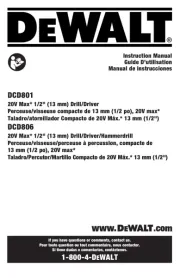
3 Augustus 2025
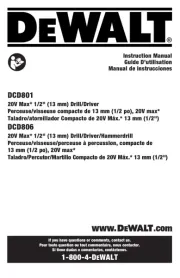
29 Juli 2025

4 Juli 2025
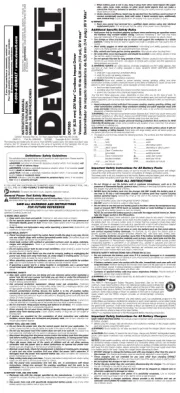
10 Juni 2025

2 Januari 2025

22 November 2024

15 November 2024

2 November 2024

23 September 2024

11 September 2024
Handleiding Boormachine
- Ribimex
- Max Bahr
- NEO Tools
- King Craft
- McKenzie
- Bort
- Duro Pro
- Cotech
- Goon
- Berner
- Meec Tools
- Rok
- Bosch
- Total
- G-Technology
Nieuwste handleidingen voor Boormachine
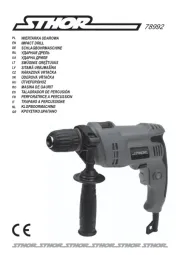
13 September 2025
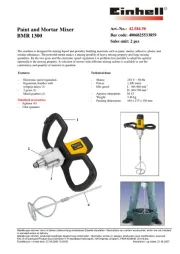
13 September 2025
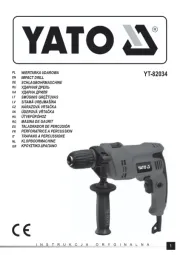
12 September 2025
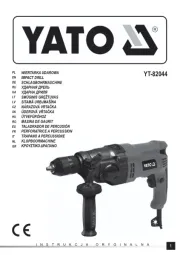
12 September 2025
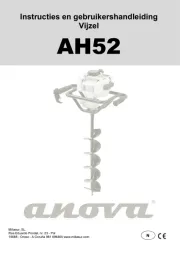
9 September 2025
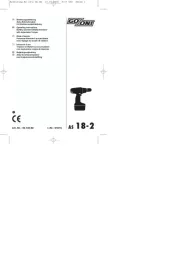
8 September 2025
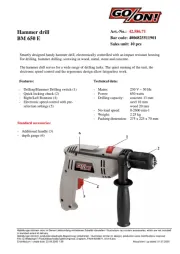
7 September 2025
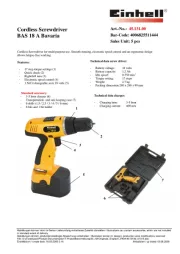
2 September 2025
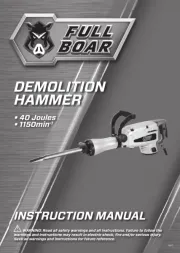
2 September 2025
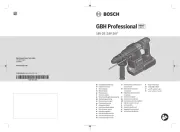
2 September 2025